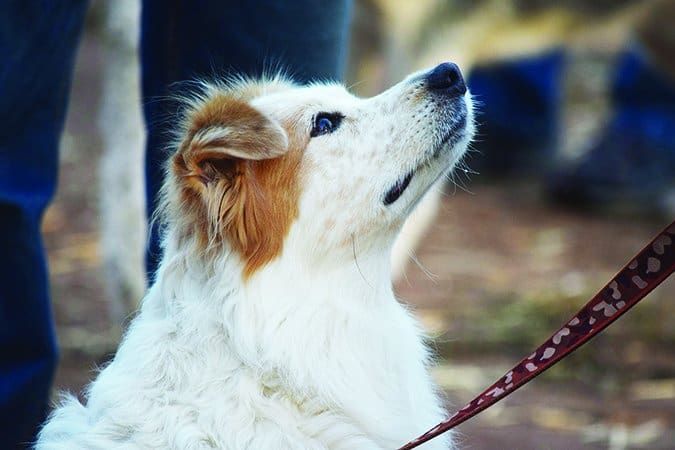Almost 30 years ago, The 7 Habits of Highly Effective People by Dr. Stephen Covey was published for the first time. The self-help book went on to be called the “most influential business book of the 20th century.” To date, more then 25 million copies of the book have been sold.
As a small business owner, I found the book very enlightening and helpful, but I mostly found myself relating to Dr. Covey’s “7 habits” as things that would really help anyone who lived with and worked with dogs!
As a professional dog trainer, I get to work with people from all walks of life and the dogs they love. Interestingly, no matter who they are, what they do for a living, or what kind of dog they have, their issues are similar: They call me because they want their dog to stop doing “X.” Usually, they say they have “tried everything, but the dog just won’t listen.”

I love the opportunities I have to work with so many amazing dogs. But a lot of what I do comes down to coaching the dog’s owners on how to look at things differently to obtain a new outcome.
With Dr. Covey’s “seven habits for success in business” in mind, allow me to apply them to people who want a more successful relationship with their dogs.
1. Be proactive.
Much of the old-fashioned dog training we were exposed to growing up focused on waiting for the dog to make a mistake and then harshly correcting him. While most of us simply accepted this as “how you train a dog,” we were missing the bigger picture. This method never taught the dog what he was supposed to do in that situation the next time.
It doesn’t make sense to let an untrained dog loose in your house and then follow behind correcting him with “No! Don’t! Off! Stop! Get down! Quit that!” for every wrong decision he makes. It is much more effective and productive to take the time to teach this new family member how to act appropriately in your home.
In modern, science-based animal training we understand the importance of teaching the learner, in this case the dog, what to do by being proactive. To use the example above as what not to do when you bring your new dog or puppy home, start things off on the right foot by first showing your new family member where she is supposed to go potty – before you ever bring her indoors! Stay out there until she goes, and immediately reward her with treats and praise!
Then, instead of turning her loose in her new home, allow your new dog to have access to just one room or area in the house at first – a place where she won’t be able to make mistakes like jumping up on the bird cage, soiling a precious rug, or chewing up a family heirloom. Allow her to relax in an area where it’s safe to explore without being able to make any major mistakes and where her water, food, toys, and beds are located. Reward her for sitting politely as she meets each member of the family and each visitor to the home!
Dogs do what works for them and what’s safe for them. If you introduce behaviors that are safe for the dog and work for you both, your dog will begin to choose them naturally.
2. Begin with the end in mind.
To change an unwanted behavior, you first need to decide what you want your learner to do instead. It is very easy to say, “I want my dog to stop jumping” or “I don’t want my dog to bark at the mailman.” You need to turn that around and decide exactly what you’d rather have your dog do in those moments.
To modify the unwanted behavior, we must be able to picture the final goal. If your dog is jumping on guests, you would probably prefer that he sit politely instead. If your dog is barking, you may decide you want him to play with his toy or go to his bed while the mailman passes by. These are the finished behaviors you can have in mind so you know exactly what you’re going to teach your dog to do.
If you don’t have a goal in mind and you’re only focused on stopping a behavior, your dog will never learn what he’s supposed to do the next time a guest comes to visit or the mailman delivers a package. This will set up an endless cycle of wrong behavior, harsh correction, confused and scared dog, frustrated guardian. This cycle can be broken easily if you begin dealing with your dog with your end goal in mind.
3. Put first things first.
Prioritizing is a necessity in all aspects of our lives. Working with your dog is no exception. There will probably be several things you wish to change or work on with your dog, but certain ones should take precedent. Any behavior that is necessary to keep your dog and other family members safe should be a top priority. This could be teaching your dog to come when called because you live near a busy street. It may be working on creating positive associations for your dog with babies because you’re expecting. If you’ve recently brought home a new puppy, proper and humane socialization should be your number one priority due to the brief window of time puppies have to learn about their world and whether it’s safe.
Focus on teaching your dog whatever behaviors meet your immediate needs; usually, the rest can be handled with proper management such as baby gates, fences, a leash, stuffed food toys, etc. There is nothing wrong with using management to keep everyone safe and happy until you have a chance to work on that next issue with your dog.
4. Think win-win.
Always think in terms of mutual benefit when working with your dog. I doubt you added a dog to your family to spend the next 10 to 15 years in an adversarial relationship. Therefore, it’s not helpful to think in terms of dominating your dog or expecting your dog to spend his life trying to please you.
Instead, make the things you ask your dog to do just as beneficial for him as they are for you. Thankfully, this couldn’t be easier, since most dogs will gladly work for food, toys, praise, and/or petting.
Your relationship with your dog should be like any other in your family, built on mutual respect and love for one another. If you stop and consider how your dog must feel in a given situation – just as you would for your partner or child – you can then approach it in a way in which you both receive what you need in that moment: a win-win.
5. Seek first to understand, then to be understood.
Humans are quick to demand full and complete comprehension from our dogs. It’s surprising when you consider we expect this from an entirely different species – one that doesn’t speak our language! On the flip side, consider that dogs speak to us all day long with their ritualized body language. Sadly, the majority of humans have never learned this language.
Dr. Covey wrote in his book, “Seek first to listen with the intent to understand the thoughts and feelings of others, then seek to effectively communicate your own thoughts and feelings.”
We must remember that our dogs have their own thoughts and feelings and that the environment we subject them to affects both. If you cue your dog to sit or lie down while at the vet clinic or on a busy street corner and he doesn’t do it, it’s not because he is being stubborn. Your dog may be scared, anxious, or overwhelmed in this situation and feels that it would be unsafe or uncomfortable to sit or lie down. He is not defiantly disobeying your orders. He is responding to his instinct and emotions in the moment. Every one of us does this when we feel scared or threatened.
Learning how your dog communicates with his body means you care about this family member with whom you share your life. It also shows your dog that he can trust you to help him out of overwhelming moments and you will understand what he needs. What an amazing gift to be able to offer him!
6. Synergize.
This means recognizing your own strengths and celebrating the strengths of those around you. You may have adopted a dog because you thought it would be nice to visit nursing homes and cheer up people with a sweet, fluffy therapy dog. However, the dog you end up with might be full of energy and better-suited for an agility field.
Instead of seeing this as a failure in your dog’s ability to be a therapy dog, consider the amazing possibilities you could have doing something more active together. Perhaps this unexpected development will open up a new world to you, with like-minded friends and fun travel. (And perhaps your dog will grow to share your interest in providing comfort to people later in his life!)
Just as you would with a child, try meeting your dog where he is, accepting him for who he is today. Be open to discovering the wonderful gifts he can bring to your life right now.
7. Sharpen the saw.
There isn’t an individual on this planet that ever stops learning. In fact, learning is always taking place, even when we don’t realize it.
If you think of training a dog as something you do haphazardly (when you find the time) for the first few weeks he’s in your home, you will not be happy with the results. Alternatively, if you weave training into your everyday life with your dog, thinking of each brief interaction as a teaching moment, you will be amazed by the outcome. Your dog will receive clear and consistent messages from you in all types of settings and situations. This will allow him to develop into a calm, confident dog who truly understands what is expected of him and which behaviors are appropriate to choose on his own.
It’s not uncommon for someone to ask me, “How long will it take before my dog is trained?” The truth is, there really isn’t an answer to this question because there should not be an “ed” on the end of the word train. As long as we are alive, learning is always happening and none of us is ever fully “trained.”
Instead of being disappointed by this and thinking that you will have to train your dog for the rest of his life, I encourage you to flip that narrative and become excited about the opportunity to share a mutual journey in learning alongside each other – a journey that builds a bond like no other.







I subscribed online this morning. I can access some but not all articles how long will it take until I can do so?
Thanks..Pam Byrne
Excellent article!! (Although I can’t stand Stephen Covey and thankfully you didn’t expound on his methods.) BUT, I have found that developing a good relationship with my dog is key and maintaining that relationship (just like human relationships) is necessary, as well. SO many people these days just expect puppies and dogs to know what to do. It’s crazy. And consistency, patience and love are critical to creating that relationship and maintaining it. Thank you so much for a wonderful article.
Love this article!
Thanks Tiffany! Great article.
Dogs want to please, and they read your body language. They are telepathic about how you are feeling right now, and they sense distress and they sense approval. So many dogs over a lifetime I have had, and never formallly trained one. Somehow each dog sensed when I was happy with them, which is most of the time, and when I was concerned about what they were doing.
Seven Pyrenees pups were pulling the cover off the sofa. Distressed, I said “No.” Seven little heads turned to look at me and said ‘But, ma, it’s fun!’ And they went over to the next sofa, and the same thing happened. Never did the seven of them do that again. They were outdoor puppies, so they had an outlet for that puppy energy.
Certain things you aren’t going to be able to prevent telepathically, especially when you’re not present. Like a Pyreneese going down the road: You gotta have a fence for these guys, or some other restraint about roaming.
Part of this kind of bond is the human compromising. Louise wanted to dig a hole right where the beautiful pink peony was. I moved the peony. In the hot weather, a plastic wading pool was a way to cool off instead of digging up the yard.
Remember that dogs can read a human’s mind, a human’s emotion, and if you have a clear idea about what you want from your canine, you really don’t have to express it much in your behavior. I guess this is being a ‘dog whisperer.’
your kidding right??
Yes, dogs can hear you telepathically, especially if you’re calm and they feel safe. With my first dog I started with formal training when she, a tiny 5 pound Yorkie, was a puppy. She was very bored with that. But I also treated her like a baby or toddler by talking to her about everything we did, explaining as we went through our day. People looked at me strangely. When she was around 9 months old I suddenly realized she understood everything I said to her, even new things. But it wasn’t until she was an old lady at 17 that I realized she understood because she was telepathic. She had cataracts and couldn’t see. The first time she got stuck in a corner I said to her you just have to back up and turn around. She followed my directions perfectly and that’s when I understood how perfectly she understood me.
You got it. Pyrenees are very telepathic. If you are too, they respect you as sthe parent. If you are not, they tend to be your parent.
People who think of dogs as subhuman have to bribe them with rewards for behavior. That’s my, possiby warped, perception.
As the above person said. You are kidding right? Seriously? You are attributing human conditions to dogs. Seriously. I think you might need a little “training” help yourself.
Excellent article. The key methods of preventing problem behavior before it starts are listed and explained so that anyone can understand. Preventing problem behavior is so much easier than trying to fix it later.
Thank you so much for Sharing this wisdom and insight. I have been distressed with my medical alert dogs new behaviors over the past couple of months. She was not reliable and her obedience, and seemed anxious. She recently had a near-fatal autoimmune episode, at which time I learned that her major organs were inflamed. She must have been in considerable pain during all that time as the inflammation gradually worsened. I never knew it. Thank you for giving me the tools I need to re-train her with sensitivity and kindness.
Great Article, Really!
I t subscribed to your newsletter. When should I expect to receive it?
excelent article
Really loved the article. We adopted a 10 year old silky terrier cross from an animal shelter earlier this year. She is absolutely gorgeous & we love her to bits. The only problem is when we are out walking & we go up a lane into a park, our dog starts getting over excited & barking very loudly as there are dogs in the yard next to the lane. I’m not sure if she is frightened of them or not & I’m not sure what to do. She gets on well with the other dog we have & our daughter’s 2 dogs as well. Any suggestions, please. Many thanks
It sounds to me that your dog is getting anxious and fearful seeing these dogs as strangers, not knowing what to expect in this situation.
My Sheltie stats barking when he is excited at seeing another dog or person he knows and wants to say, “Hi!” You can tell whether they are excited or fearful by their body language.
Try walking her past these dogs in the company of dogs she knows who are calm in this situation. Several trainers in our area do “urban walks” – taking a small number of dogs and their owners on leash walks together after the dogs have a chance to get acquainted off leash in our day care play room. The trainer has a confident dog of her own with her. All the dogs derive confidence from being among human and canine friends. It’s like having back-up. And for places where there are real risky possibilities – aggressive dogs sometimes loose, for instance– walking together and being prepared to respond makes everyone actually safer as well as more confident. It’s important to know that the dog you are walking with is not reactive, or you can make your dog’s fear issues worse.
Pam,
I too adopted an Australian Silky Terrier. I’m pretty sure he’s a pure bred, but one can’t really tell as their variation in colour for the breed standard makes it a bit more difficult. Anyway, the point I wanted to bring up with you is “Do you know where in the pack hierarchy your dog is?” This can often determine how dogs act when they meet other dogs.
My Silky is a middle of the pack guy. They (Mid pack) are usually the educator/disciplinarian of the younger dogs as well as a peacemaker. When I take him to the small dog park, where there can be up to 20 dogs present, he acts like the “fun police” and you can see him trying to referee the play of younger ones or if two dogs aren’t getting along, he’ll get in between them and talk to one and then the other as if to say, “there’ll be none of that behaviour while I’m here!”
Next time you take your dog through there observe the behaviour…do they pull away from the fence to the other side of the lane? (Fearful); Do they move toward the fence and bark? (Seeking interaction or warning away the dogs); Do they wag their tail and bark? (Possibly joyous because they know where they are going)
Your example is why many dog experts recommend NOT going to dog parks. The dogs there can be very unpredictable. You may be putting your Silky Terrier in a situation where you and he cannot control what could potentially happen. People can bring any dog they wish to a dog park–vaccinated or not, good around unfamiliar dogs, or not, friendly with strangers, or not. I use to take our dogs to dog parks, but after reading a few articles about the risks, I have stopped. I instead find people in my neighborhood whose dogs I know are vaccinated, and friendly to other dogs and people. We have play dates in our backyards instead.
Great Article!!
Thank you for such a positive and helpful article!!
Thanks Carol for your reply. This is helpful & makes sense to me, so I will be really aware of how our little girl is feeling & coping. Best wishes, Pam
We adopted our boy three years ago, when he was nine years old. It’s taken me three years to really read him, because he uses the same signals for several different things.
The dog we had before him made it totally clear what she wanted.
An article every dog owner should read! The understanding it conveys is foundational.
So happy to read this article. I was a bit in shock when we got our new puppy, a beagle/golden retriever. We haven’t had a dog for 12 yrs after having a 17 yr old poodle for so long. I think I expect far too much from this new guy. Very gentle and kind but oh so much energy. He is getting there now at 19 months
Kudos!
What a great article! Well written and so many reminders and the importance of perspective. Thank you!!
AN EXCELLENT ARTICLE! This is one every dog owner must read. A puppy or a senior dog would benefit.
Thanks!!!
This is one of the most helpful, insightful, practical articles I’ve ever read about dog training. Thank you for sharing!
I have a 3 year old Papillon. He continues to bark aggressively at any dog when we walk, barks and attempts to nip/bite peoples feet and angles. We had him at a 2 week boot camp, we hired a trainer that walked with us, we have purchased devices to redirect, we have given treats when he try’s to be good. None of it is working. It is just a nightmare to walk him are take him out to coffee or a restaurant. My question is can he ever really be trained to act differently.
He tries to bite people he has met several times, including my son who has been staying with us for months.
What is funny is he is a champion show dog… how did that ever work…is it me?
Positive reinforcement doesn’t work as well with some dogs. He needs to learn to respect you and listen to you and the way to get his attention is with a shock collar. I have had many dogs over the years, but none were like the miniature dachshund my brother “gifted” me with at ten weeks. I quickly learned that this little fur baby is unlike any dog I’ve had. I call him a little indomitable soul – tenacious, fun-loving, out-going, playful, tough, and resilient. And, he thinks he is the alpha, despite despite one of his pack mates being a 70 pound GSD. His major bad habit is biting or nipping other dogs when playing. Nothing I did made him stop this behavior for more than a few minutes. Finally, out of desperation, I bought a shock collar on Amazon for small dogs. It has a vibration, sound, and then shock choice. I made sure I verbally corrected him, followed by the vibration, and if he didn’t stop that was followed by a shock (I’ve only shocked him about three times – on low). Now, all I have to do is put the collar on him and it doesn’t matter if it is charged or not, because when it is on him he minds me perfectly. I know a lot of people will not agree with this method, but we live on a corner with no yard fence, and he needs to mind me and pay attention for his own safety. If you choose to go with this method, it is important that you verbally correct him with consistent commands each time before using the collar. Otherwise, it is like punishing a child without telling them what they’ve done wrong. Also, when he is behaving as you want him to, be sure to praise him for the positive behavior.
I’ve had similar problems with a 7-year-old rescue who is very “reactive” to other dogs, and very distrustful of humans. Cant tell if it’s fear or something else. Maybe a mix of that and frustration. Maybe the huge life change–I think she was used for breeding in her earlier life. Tried training with little benefit. Vet finally put her on Prozac, saying she was too anxious to learn. took a couple of months, but she has changed enormously. We have been able to bond, and there is no more snarling or nipping. Still dog reactive, but learning slowly.
This is a great article and I love Whole Dog Journal. The photo of the grey dog being taught a down looks far too thin to me. We don’t want to promote the idea of deprivation as a motivator. I don’t want to see this many ribs in a healthy dog!
I would want to see a retraction regarding this photo chosen for this article.
The cover photo for this article depicts a dog who, in my opinion, is far too thin! You can see every single rib in detail…
I agree, and am surprised that this photo was used.
Everything that was written makes perfect sense to me! I will apply this to my training.
Miriam
I fostered a dog that was abused and locked in a crate for her first year, I would like to crate train her myself but in a positive way. Every time I put her in the crate even for a minute it upsets me which upsets her. I want her to know that she’s going to come back out of the crate not be locked inside. Thanks for any help you can give me
That photo of the underweight dog being trained is very disturbing. I don’t know if this was originally a stray and if it was I could understand the weight loss. If it has been and always was a dog with one owner, that owner needs to feed their pet better.
It’s very effortless t᧐ find out any topic on web as
compared tо books, as I fοund this piece оf writing at thіs website.
All I can say is…what an EXCELLENT and well written article! This will definitely be posted on my FB page!